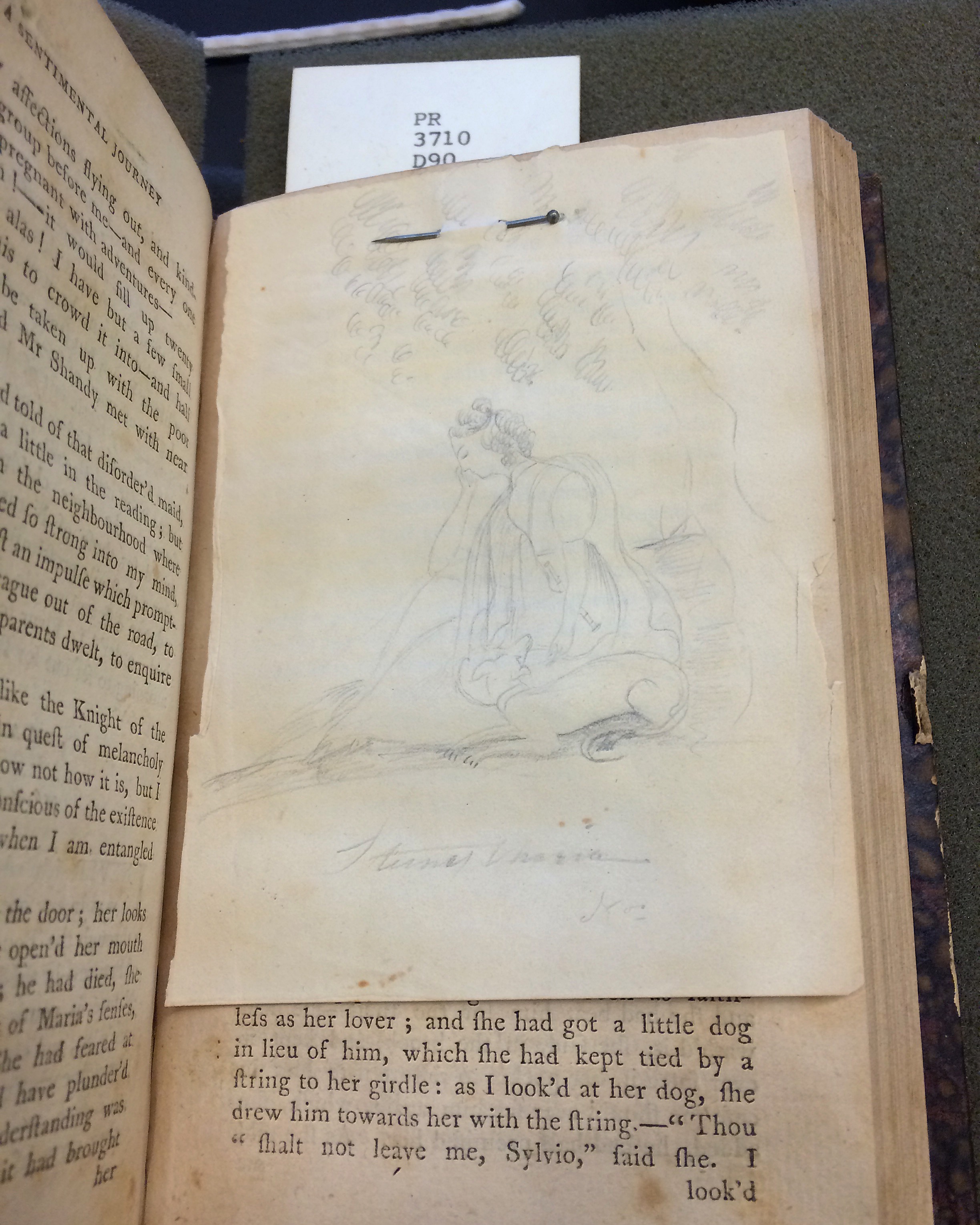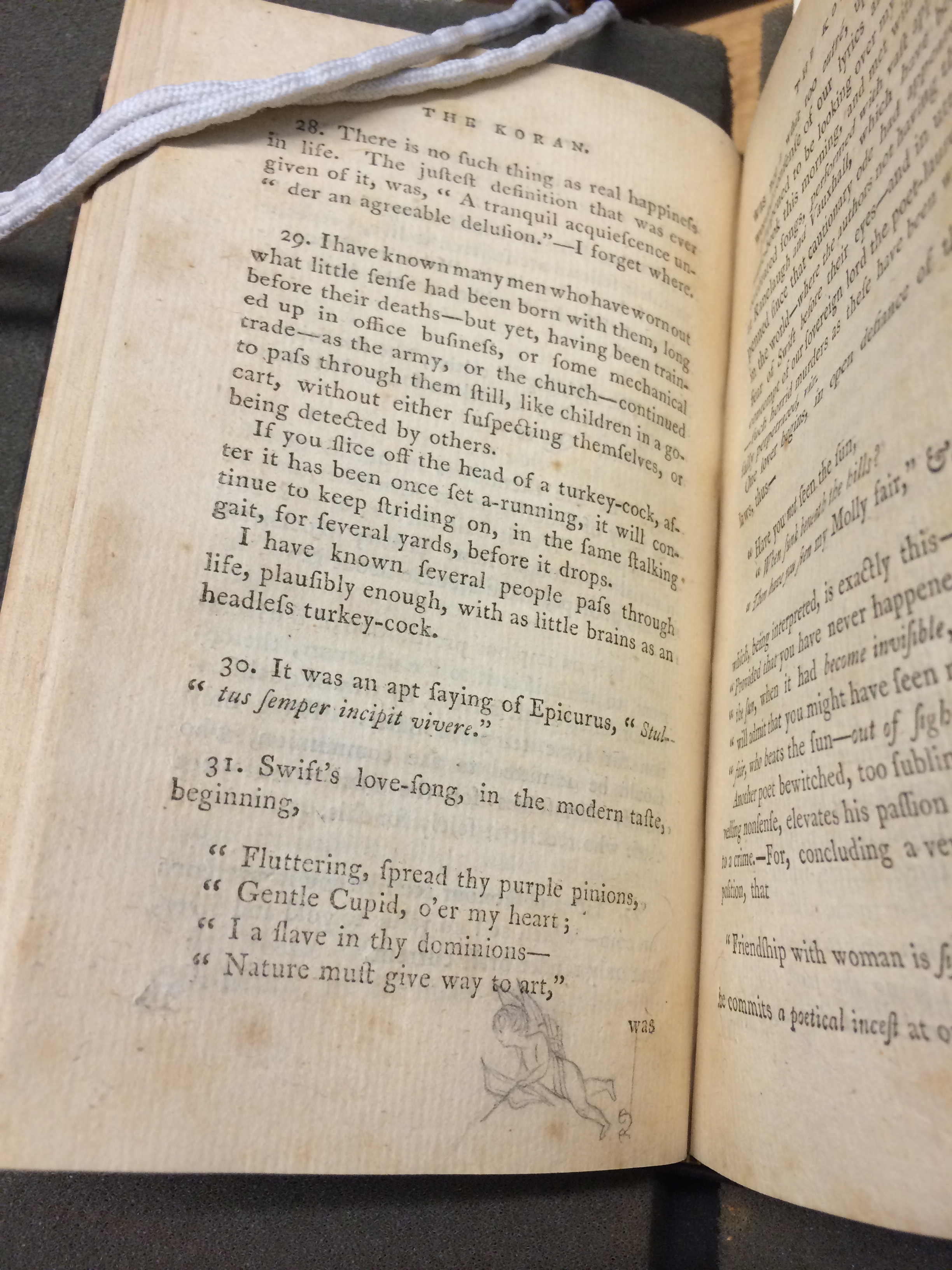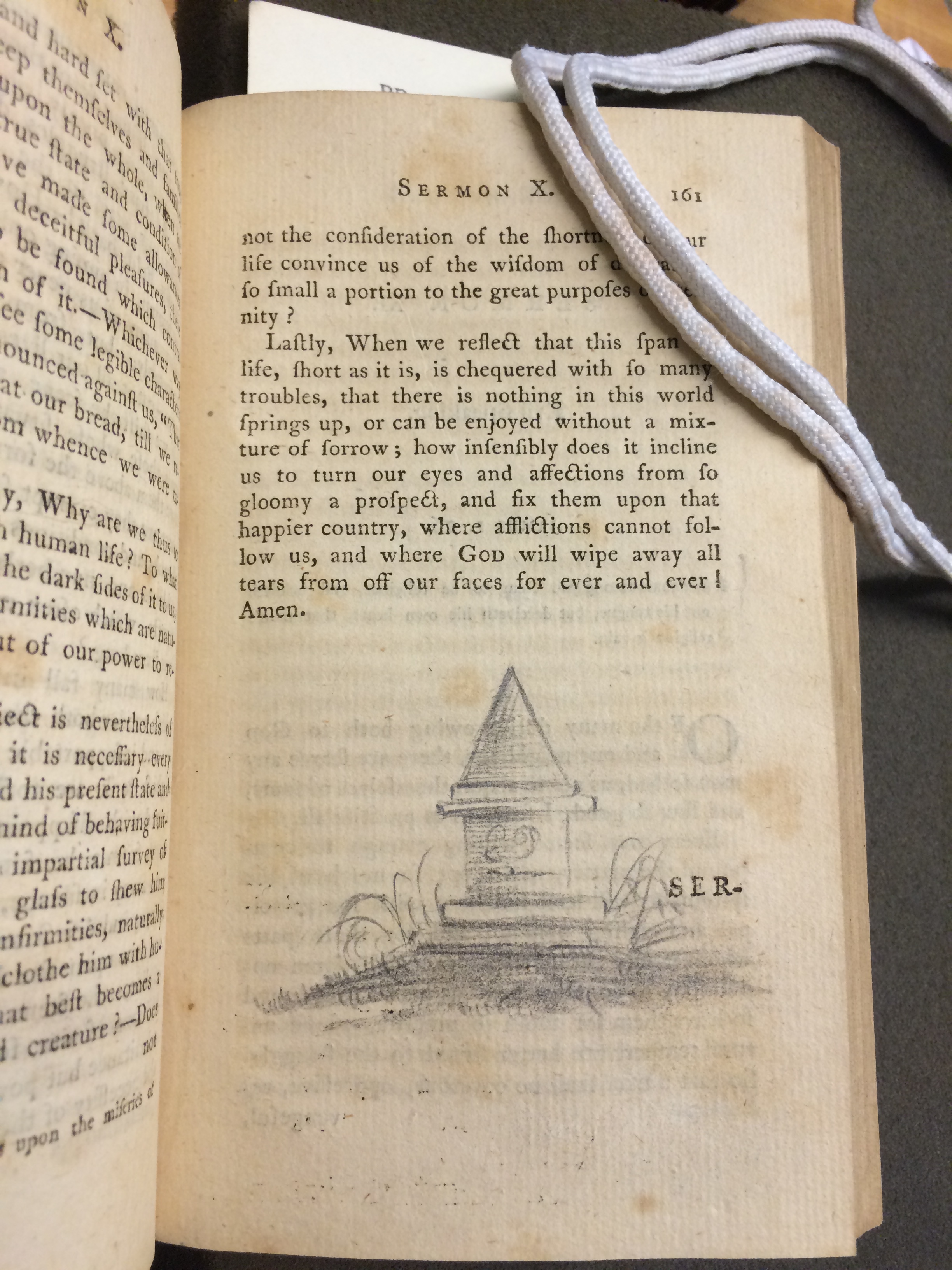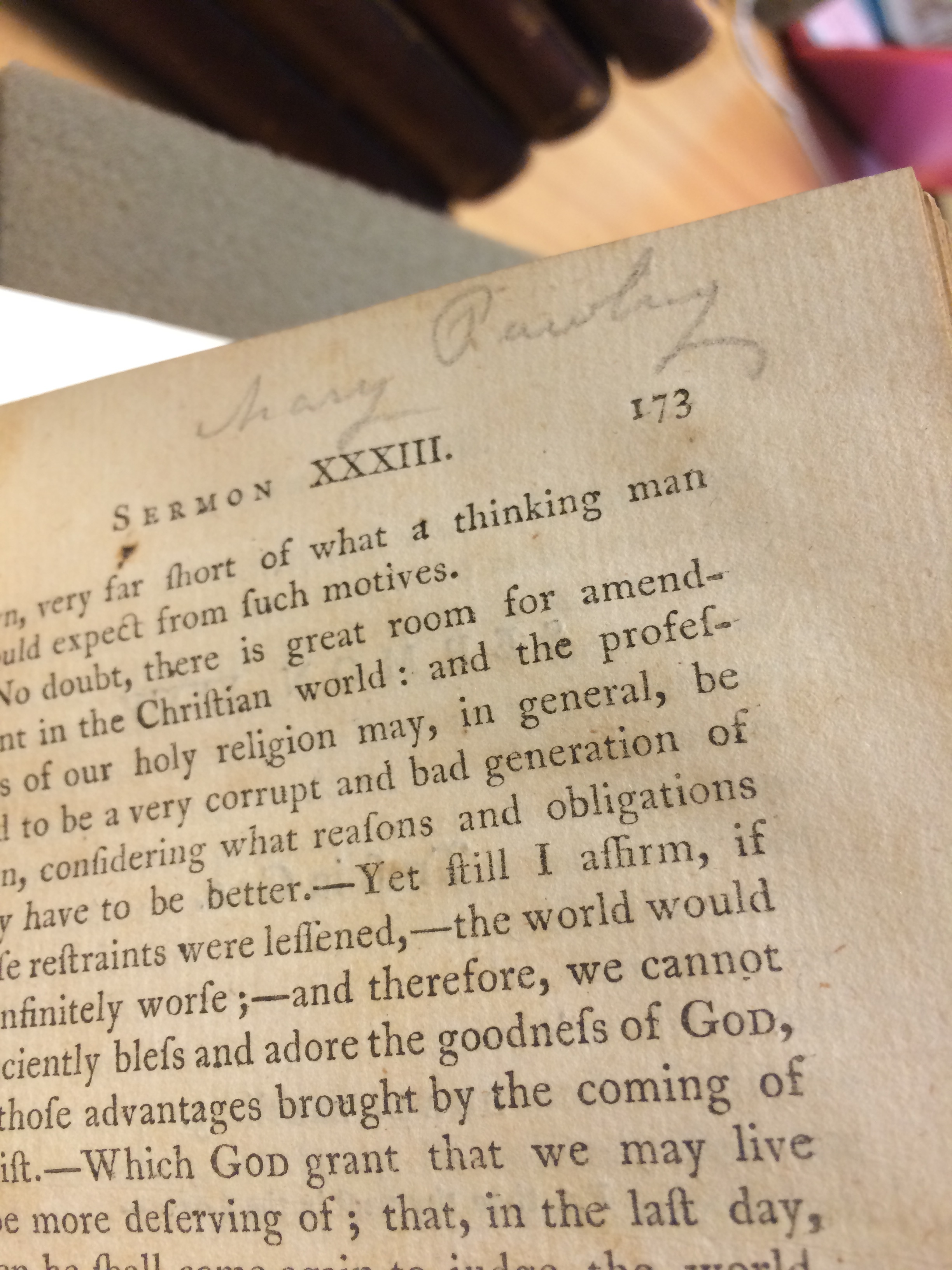Accessing the Community of Readers: Marginalia in Rare Books Libraries
Marginalia and the Pawling Family
Levi Pawling was born in 1773, admitted to the bar in Norristown, Pennsylvania in 1795 and married in 1804 to Elizabeth Hiester. He was a career lawyer, and though his local government was largely run by Democrats, he also served as a one term senator as a Federalist from March 4, 1817 to March 3, 1819. Pawling wore many hats over the course of his life, from congressman to burgess of Norristown to president of the board of directors of the Bank of Montgomery County to father. Over the course of his marriage to Hiester, Pawling fathered seven children: Elizabeth, Ellen, Rebecca, Mary, Joseph H., James M., and Henry DeWitt (Wiley 419). Ellen, born in 1816, married another Pennsylvania lawyer from Norristown, Henry Freedley, in June of 1845, just before her father’s death in September of that year. After Ellen’s own death in 1850, her sister Rebecca, born in 1815, married her widower. The marriage of Rebecca and Henry Freedley was even shorter than that of Ellen and Freedley, however, as Rebecca died in November of 1851, only eight months after her wedding (Bull 54). Though Freedley lived a much longer life, surviving until 1894, he, Rebecca, Ellen, and Levi are all buried in the churchyard of the parish that Levi founded and presided over as church warden, St. Johns Episcopal Church in Norristown, PA. Levi’s other daughter, Mary, born 1819, married yet another Pennsylvania lawyer, Sylvester Norton Rich in 1846. Their marriage lasted much longer than either of her sisters’, continuing until Rich’s death in 1893. Rich and Mary were both buried in the Odd Fellows Cemetery in Philadelphia.
But between that, between all of the marriages and politics and birth and death, Levi Pawling owned an edition of The Works of Laurence Sterne (1790), an eight volume collection of Sterne’s novels, letters, sermons, and various bits and pieces he had written for other publications. Levi signed his name in several of the volumes, with his name first appearing in volume three. The inscription reads: “Levi Pawling’s Oct. 1st 1800.” His daughter Rebecca’s name is in six of the eight volumes, sometimes written more than once. On a half title page at the start of volume one, Rebecca followed a similar inscription pattern to her father, writing: “Rebecca Pawling, January 6th 1836.” Her eventual husband’s name, Henry Freedley appears on the full title page in every volume in the exact same spot, as “Henry Freedley C.E.” is inked in between the words “COMPLETE IN EIGHT VOLUMES” and “CONTAINING.” Mary Pawling’s name appears only once, at the top of page 173 in volume eight, containing Sterne’s sermons.

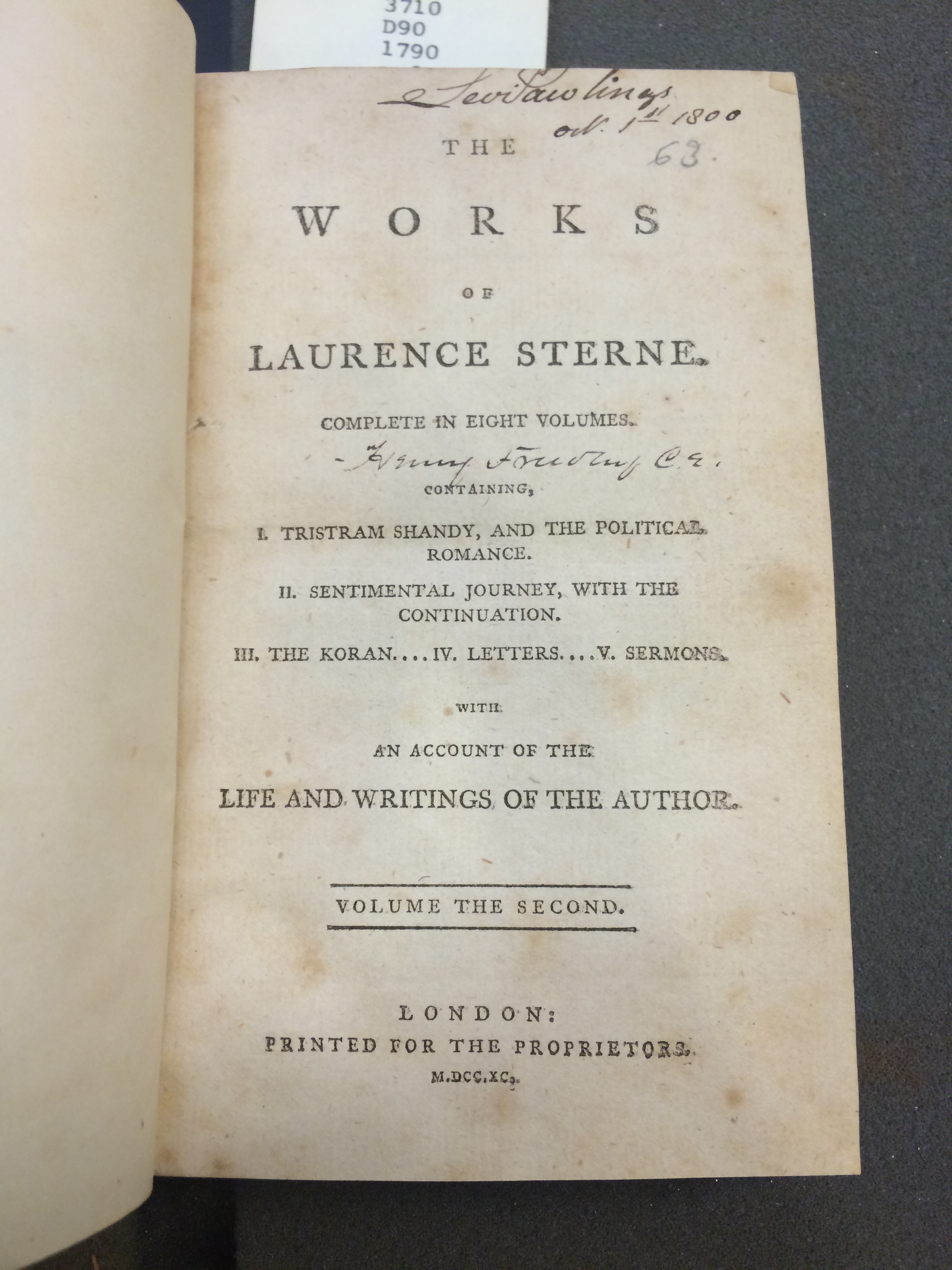
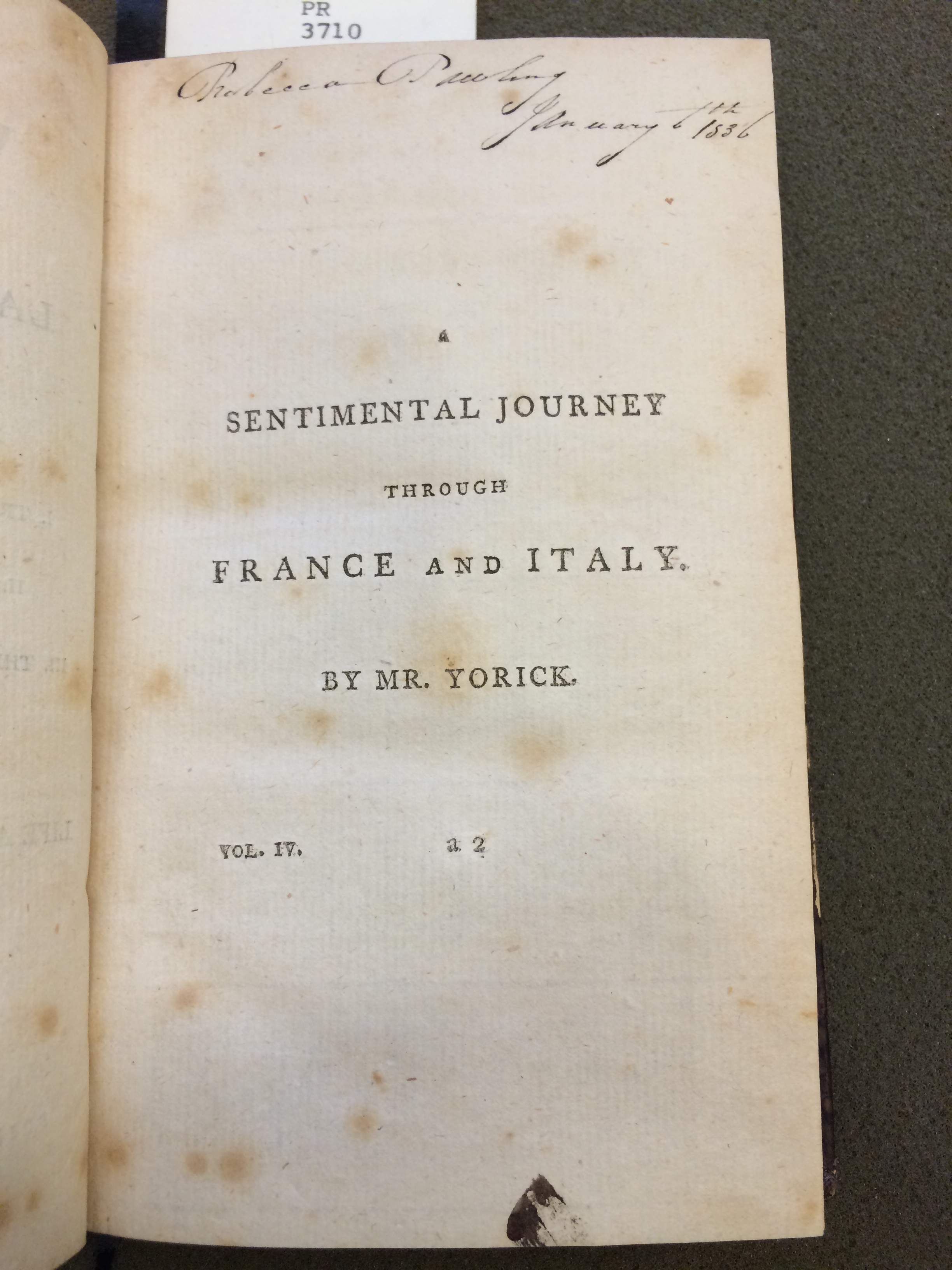
But whether these family members inscribed their names once or a hundred times, the inscriptions allowed them to generate a community of readers. As the lovers in John Donne’s “The Canonization” are immortalized and interred in the poem which acts as their urn, so are the Pawlings contained in these volumes, together and interacting for as long as the books continue to exist. Mary and her husband may have been buried in a different cemetery from the rest of the members of the family whose names are inscribed in this book, but in these pages they reside together, and the inscriptions help to create a narrative out of their relationships. Levi had the book first, obviously, as none of the others were born yet in 1800, the date of the first inscription. After that, perhaps, it passed to Rebecca, who would have been twenty one when she put her own name in the volumes. Or maybe Mary went through them first, reading and marking up the passages that mattered to her, and then passed it onto her sister. From Rebecca, they might have passed to Henry.
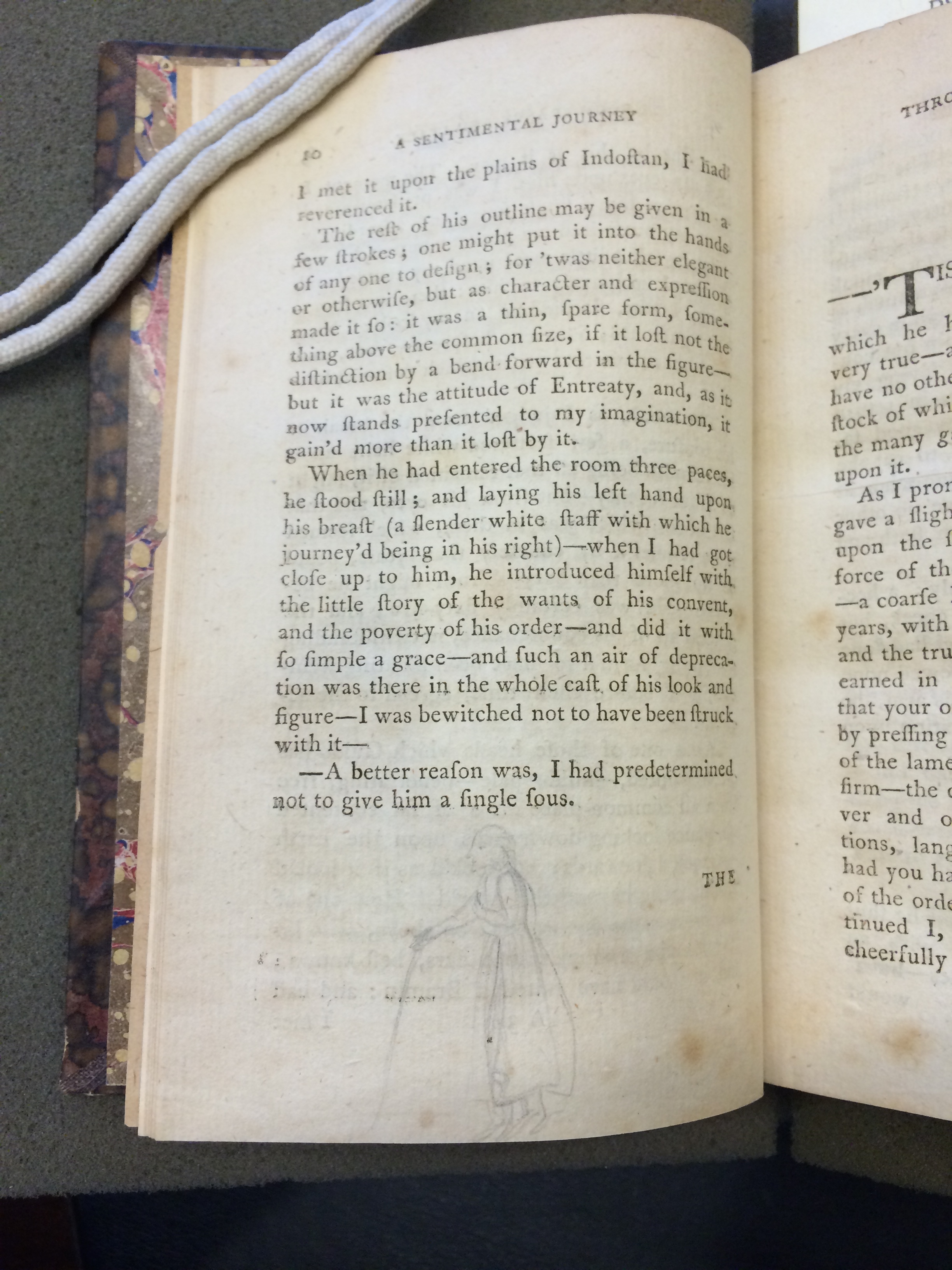

In light, feathery pencil, someone has written “January 1832” on page 144 of volume seven. A similar light and feathery pencil has used the book as a sketch pad, doodling myriad birds and flowers in the margins, and sketching various ladies and gentlemen in many of the blank spaces left at the end of chapters. Someone has even taken the trouble to illustrate a scene from A Sentimental Journey in which a character named Maria sits with a dog in her lap under a tree. In this case, there was not enough blank space to accommodate the artist, who instead composed her illustration on a small sheet of paper and attached it to the page with an actual pin, similar to the type of pin used for hemming clothing. All of the margin notes are also in pencil, though there is no telling whether the same hand made them all. It is possible that Levi Pawling, Rebecca Pawling, and Henry Freedley signed their names in ink at the start in order to make bolder and more permanent claims of ownership, while they made margins notes in pencil so as not to overwhelm the text. However, it is also possible that the pencil marks, the words written in the margins, and the sketches that might have been a product of the artistic component of the education of young ladies in the nineteenth century might have all been produced by Mary Pawling, whose name also appears in pencil and in the middle of a text, as if in the midst of reading she suddenly felt the urge to put herself in these pages and test out a signature. The placement of Mary Pawling’s name is more suggestive of usage than ownership.
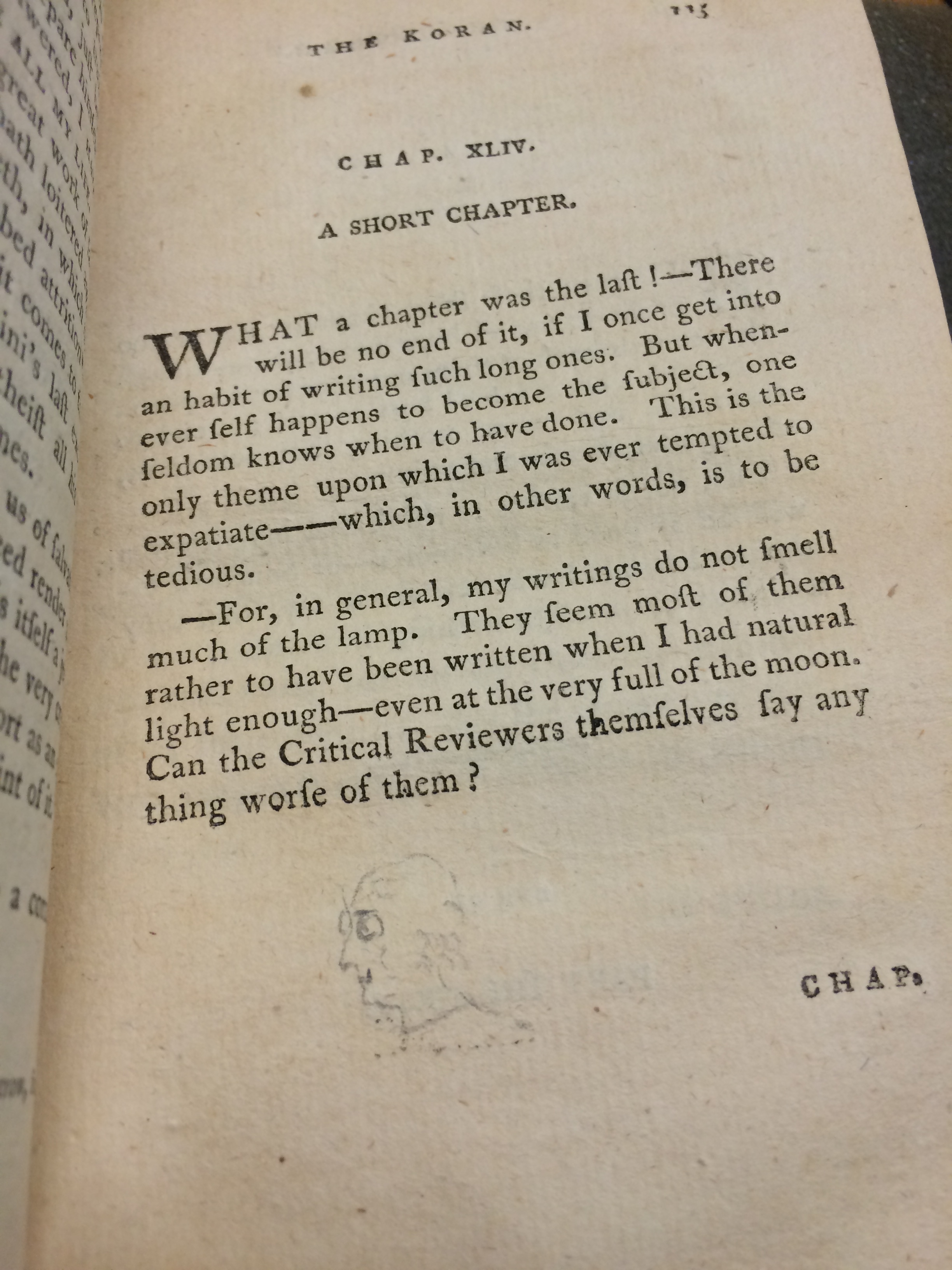
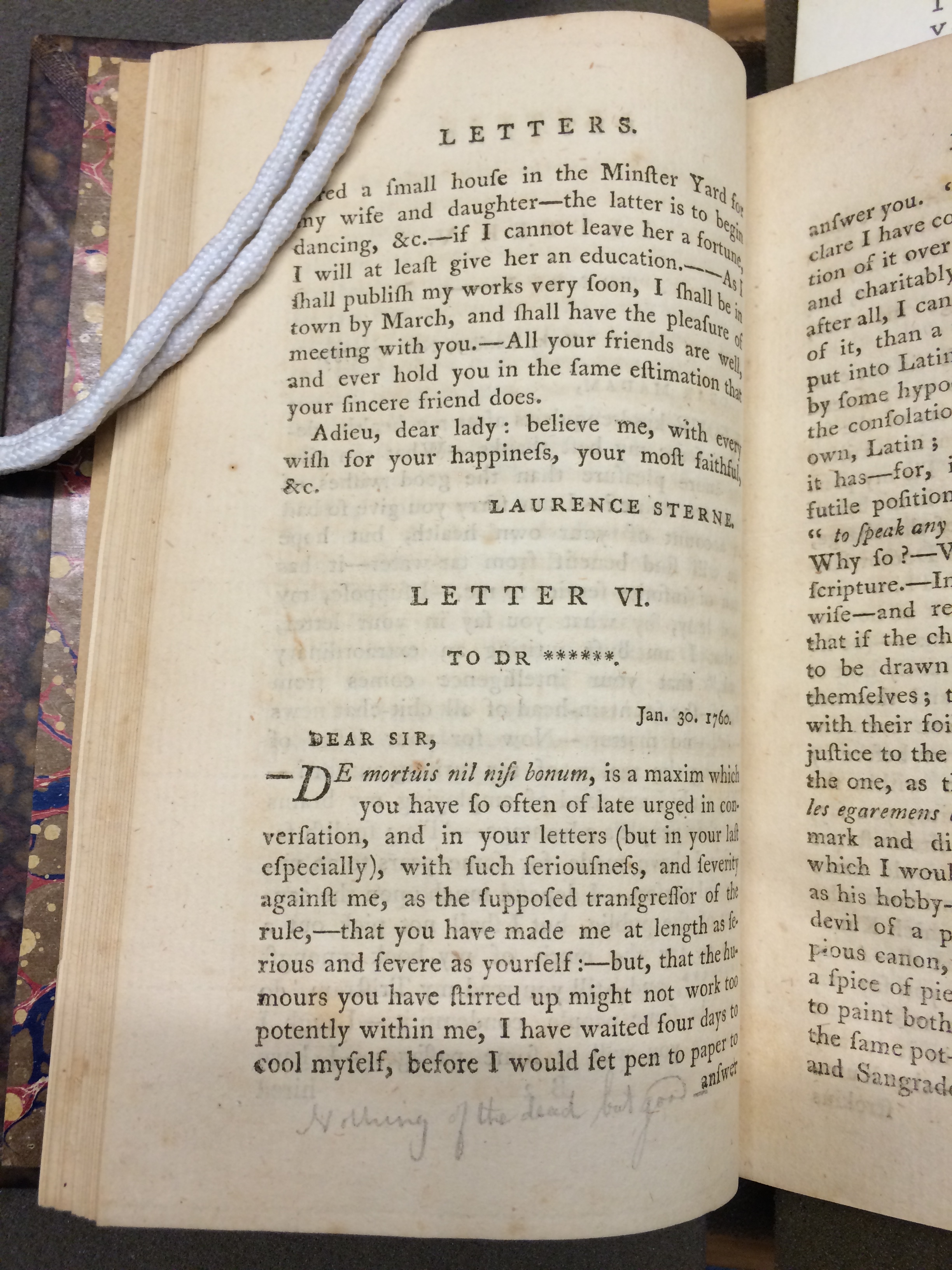
On these details, I can only speculate, though that speculation itself results in more detail being added to the web of this family’s pattern of association as their names are brought into contact again and again in varying ways and orders. In fact, the speculation greatly expands the web, for now, I can add my own name to the web. Now I have had contact with Levi and Rebecca and Mary and Henry, similar to the way they had contact with each other. The community of readers has expanded, but both includes me and does not include me.
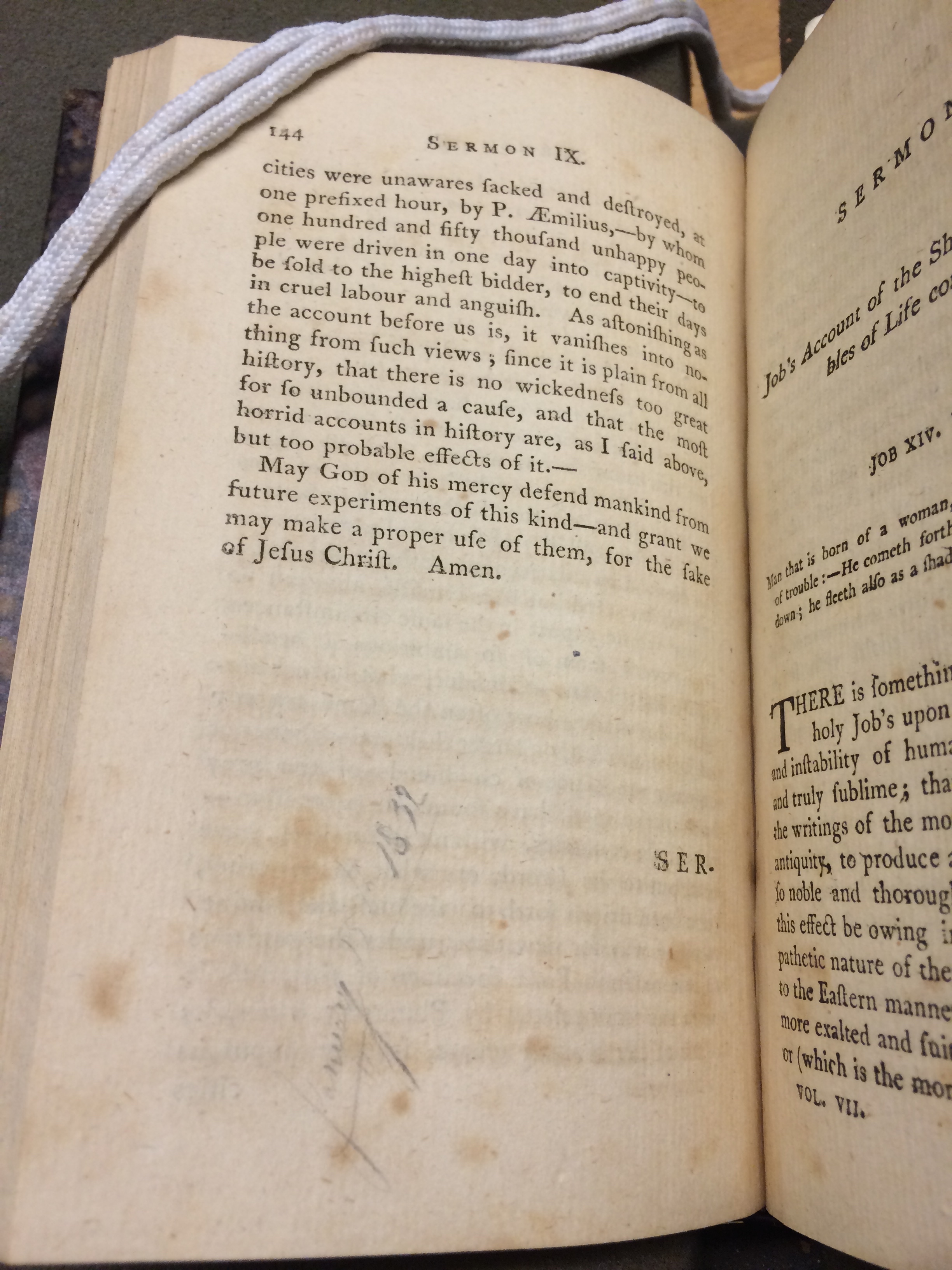
Books as Ephemeral Objects
Reading is sometimes viewed as an act of consumption. Writers produce and readers consume. However, reading is more complicated than that. Readers must produce in the same way that writers do, absorbing the words and building the framework around them, picturing scenes and bringing characters to life. The problem with that is that there is no physical trace of that. When one writes, one makes something that other people can see. When one reads, one makes something that only they can see. Marginalia provides a middle ground between those two acts; marginalia is the physical result of reading, and the physicality of it allows for continued community building.
Books in the Early Novels Database’s corpus such as these volumes of Sterne might contain hundreds of years of readers and reader reactions, with eighteenth, nineteenth, and maybe even twentieth century marginalia. The community far outlasts the people who are a part of it, but it also grants them a sort of immortality, similar to the kind that we are so keen to grant to writers. Men like William Shakespeare, for example, or the aforementioned John Donne, are sometimes thought to have beaten death, living eternally through their works so that as long as their works are still read, they still exist in this world. When we write literary criticism of these authors, we use the present tense, “Shakespeare writes” or “Donne chooses” as if they are still here with us, in an eternal present. In some sense, they get to live forever. Marginalia allows for a similar life to be given to readers. Henry Freedley, and Levi, Rebecca, and Mary Pawling are still part of a community because the volume containing their names has survived beyond them.
While cataloging these volumes, I attempted to authorize their identities in VIAF (Virtual International Authority File) and WorldCat, but could not, because such databases only keep track of writers and those involved in printing and publishing. When I search WorldCat for the names of the men who printed these books, when I search “P. Wogan,” I not only find Patrick Wogan, I find links to people whose names appeared in print often in conjunction with him. WorldCat suggests the record for Patrick Byrne, John Rice, James Moore, and Arthur Grueber among others. Their community is solidified in print and proliferated in the thousands of copies of books that they worked on professionally. But most of the men and women who formed these communities of readers were not professional readers, and as such, official sources like WorldCat usually will not have any record of their interaction with these texts. They owe their continued existence as communities and as living people to their marginalia, for that is how, 200 years in the future, some random teenage girl was able to touch them. When I searched one name at a time– just Levi Pawling or just Henry Freedley— I was unable to match a person to the name. It was not until I began searching all of the names together that I was able to find them. It is only their presence in each other’s company in the pages of these Sterne volumes that allowed me to touch them.
Yes, I touched them, but I could not join them, for the existence of these books in the rare books library at the University of Pennsylvania means that they might be looked at, but not used, not in the same way that Mary Pawling used them. For reasons that are seemingly obvious, rare books libraries do not allow their patrons to go around marking up the books in their collections. Eighteenth century marginalia is valuable to them, but anything added now might be considered vandalism. The libraries preserve these books, but in preserving them, do not allow them to be really read, and there appears to be no way around this. If the books are to be preserved, it seems we must be shut off from the community of readers.
But, trapped in this apparent paradox, we must ask ourselves why the books must be preserved. Presumably, our urge to preserve comes from a sense of the historical value of the books. From the perspective of a historian, they ought to be frozen in time, preserved exactly as they are in order to allow us to see, relatively unobscured, what the original readers were like. But in a purely literary sense, this might be an incorrect approach. Assuming these books are meant to persist is a big assumption. Perhaps books are meant to be used and used and used until they disintegrate into nothingness. We cannot possibly hold onto everything, after all. Perhaps books are like that couch that exists in many a mother’s parlor room– no one is ever allowed to sit on it, making you wonder why she bought it at all. Perhaps there is more value in building the community of readers and allowing it to grow to include modern readers than in perfectly preserving the past. History is all a matter of representation anyway. What we know about the past may be no less fictional than what we know about Narnia. Why prioritize history over literature?
The ephemerality of artwork is a concept to which we are already accustomed. In an article for African Arts, Allyson Purpura explores this tension between what she views as a Western desire to preserve things and the temporary nature of some forms of artwork, asking readers to consider that whenever they see an art installation that was tailor made for one particular space, they are viewing ephemeral artwork. When the next exhibit is ready to be put in, the old one is taken out and can never again exist as it did. Other forms of artwork rely upon that ephemerality, existing because of it, not in spite of it, such as the rice flour paintings of Hindu women in India that are washed away by rain or smudged by passers by who step on them. Purpura claims that the purpose of this artwork is not a product, but the act of producing something (12). The continued process is the goal in itself, not any preservable piece of artwork. These women’s paintings in particular felt relevant to the case of the ephemerality of the eighteenth century novel, as the preface of Each Sex in their Humour, published in 1764, jumped to mind, which, though it frames the text as a found manuscript, includes a note from the author, who writes, “This was begun at a Time when I had nothing better to do, and carried on at Intervals of Leisure…” (ii). Though this is only a conceit, the novel similarly suggests that it was written for the sake of writing it, not necessarily of finishing it. At a time in which the author had nothing else to do, she took up writing to stave off boredom in her “voluntary exile,” just as Stephen Huyler, whom Purpura quotes in her discussion of the rice flour paintings, claims that those Hindu women are painting as “a means of coping with the present.” They are not for the future and they are not about preserving the past. They are about occupying the present.
Occupying the present is all that we can ever really do, and all these objects can do, even the ones that are historically significant. As Michèle Valerie Cloonan argues in an article concerning the future of archiving, these objects can never be entirely abstracted from the modern context in which they now exist (235). The object in front of us now is not quite the same object that was in front of a reader in 1817. Context strongly affects the way we perceive objects’ meaning and the way we construct narratives around them. Even when we attempt to place ourselves in the mindset of someone from 1817, part of that process involves imagining their mindset, and we imagine their mindset differently now than we did even ten years ago because we are constantly acquiring new information and writing and rewriting narratives. Furthermore, as Cloonan aptly points out, putting these books away in a rare books library does not actually stop them from aging. Simply the fact that time passes is enough to change these books, even if it may be in a small way. Pigments fade and oxidize, ink fades and bleeds, and pages become brittle. No matter how well we take care of these books, they still age, and as such, still have an expiration date of sorts, even if it is long deferred.
That expiration date may not be a bad thing, however. As Purpura alleges, “The ephemeral amplifies the present by giving it a temporal frame” (14). It is the limited nature of the objects and concepts that exist in the ephemeral present that makes them more valuable to us. Knowing that something is temporary forces us to pay attention to it while it is there; the good that it does is concentrated. Instead of small, steady goodness, the ephemeral object displays an intense flash of goodness. Linking this back to marginalia, it suggests to me that though these books may not survive their own usage, they might have a more significant impact on their readers if we allow them to be ephemeral objects. Instead of many people having brief encounters with these books, fewer people might have passionate affairs with them. The communities that exist within them might not be immortal, but they will be strong and complex. If we were to allow special collections books to continue collecting marginalia, to allow twenty first century readers to access the historical community of readers, we would lose these books, but we would truly use them first.
Bibliography
Bull, James H., Commodore. Record of the Descendants of John and Elizabeth Bull: Early Settlers in Pennsylvania. The Shannon-Conmy Company, 1919.
Cloonan, Michèle Valerie. “W(H)ITHER Preservation?” The Library Quarterly: Information, Community, Policy, vol. 71, no. 2, 2001, pp. 231–242. JSTOR, www.jstor.org/stable/4309507.
Each Sex in their Humour: or, the Histories of the Families of Brightley, Finch, Fortescue, Shelburne, and Stevens. Printed for the Editor, 1764.
“The History of St. John’s.” St. John’s Episcopal Church. http://www.stjohnsnorristown.org/history.html. Accessed 23 June 2017.
“Pawling, Levi, (1773-1885).” Biographical Directory of the United States Congress, http://bioguide.congress.gov/scripts/biodisplay.pl?index=P000147. Accessed 23 June 2017.
Purpura, Allyson. “Framing the Ephemeral.” African Arts, vol. 42, no. 3, 2009, pp. 11–15. JSTOR, www.jstor.org/stable/20627005.
Sterne, Laurence. The Works of Laurence Sterne: Complete in Eight Volumes. Printed for the Proprietors, 1790. Currently housed in the University of Pennsylvania’s Kislak Center.
Wiley, Samuel T. Biographical and Portrait Cyclopedia of Montgomery County, Pennsylvania, Containing Biographical Sketches of Prominent and Representative Citizens of the County, Together with an Introductory Historical Sketch. Biographical Publishing Company, 1895.
